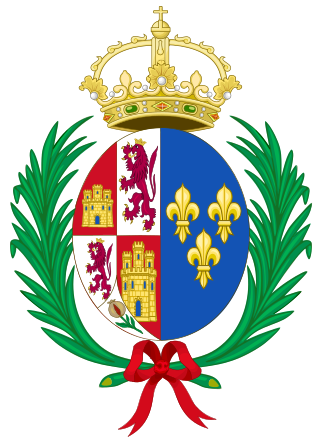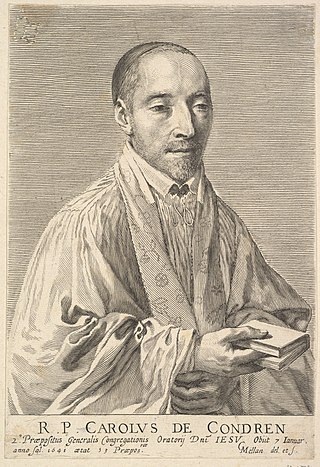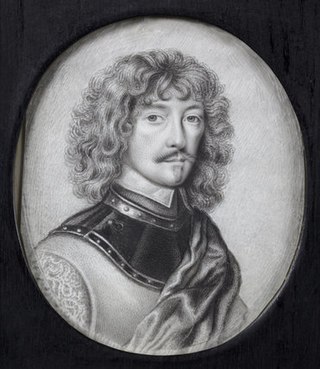
William Cavendish, 1st Duke of Newcastle upon Tyne, KG, KB, PC was an English courtier and supporter of the arts. He was a renowned horse breeder, as well as being patron of the playwright Ben Jonson, and the intellectual group known as the Welbeck Circle.

Mary, Princess Royal, was an English princess, a member of the House of Stuart, and by marriage Princess of Orange and Countess of Nassau. She acted as regent for her minor son from 1651 to 1660. She was the first holder of the title Princess Royal.

Elisabeth of France or Isabella of Bourbon was Queen of Spain from 1621 to her death and Queen of Portugal from 1621 to 1640, as the first spouse of King Philip IV & III. She served as regent of Spain during the Catalan Revolt in 1640-42 and 1643–44.

Maria Luisa of Parma was, by marriage to King Charles IV of Spain, Queen of Spain from 1788 to 1808 leading up to the Peninsular War. Her relationship with Manuel Godoy and influence over the King made her unpopular among the people and aristocrats. She was rivals with the Duchess of Alba and the Duchess of Osuna, attracting popular attention. The death of her daughter-in-law Princess Maria Antonia of Naples and Sicily, whom she disliked, was said to be the poisoning by the Queen.

Louise-Marie Thérèse Charlotte Isabelle of Orléans was the first queen of the Belgians as the second wife of King Leopold I from their marriage on 9 August 1832 until her death in 1850. She was the second child and eldest daughter of the French king Louis Philippe I and his wife, Maria Amalia of the Two Sicilies. Louise rarely participated in public representation, but acted as the political adviser of her spouse. Her large correspondence is a valuable historical source of the period and has been published.

Anne Henriette of France was a French princess, the twin of Louise Élisabeth of France. She was the second child of King Louis XV and his queen consort, Marie Leszczyńska.

Sancia of Majorca, also known as Sancha, was Queen of Naples from 1309 until 1343 as the wife of Robert the Wise. She served as regent of Naples during the minority of her stepgrandaughter, Joanna I of Naples, from 1343 until 1344.

Susan Feilding, Countess of Denbigh, was an English courtier. She was First Lady of the Bedchamber to Queen Henrietta Maria in 1626–1652.
Robert Phillip was a Scottish Roman Catholic priest, the confessor to Henrietta Maria of France.

Henrietta Maria was Queen of England, Scotland, and Ireland from her marriage to King Charles I on 13 June 1625 until Charles was executed on 30 January 1649. She was mother of his sons Charles II and James II and VII. Contemporaneously, by a decree of her husband, she was known in England as Queen Mary, but she did not like this name and signed her letters "Henriette R" or "Henriette Marie R"

The Congregation of the Oratory of Jesus and Mary Immaculate, best known as the French Oratory, is a society of apostolic life of Catholic priests founded in 1611 in Paris, France, by Pierre de Bérulle (1575–1629), later a cardinal of the Catholic Church. They are known as Bérullians or Oratorians. The French Oratory had a determinant influence on the French school of spirituality throughout the 17th century. It is separate and distinct from the Oratory of Saint Philip Neri, which served as its inspiration.

Charles de Condren, Cong. Orat., a Doctor of the Sorbonne, was a French mystic of the 17th century, and is considered a leading member of the French School of Spirituality.

Marie Louise d'Orléans was Queen of Spain as the wife of King Charles II. She was born petite-fille de France as the daughter of Duke Philippe I of Orléans and Princess Henrietta of England. Marie became the Queen of Spain on 19 November 1679, and remained in her post until her death in 1689 from the presumed cause of appendicitis.

Henrietta Anne of England was the youngest daughter of King Charles I of England and Queen Henrietta Maria.
Henrietta Gordon was a Scottish-born courtier, a maid of honour to Princess Henrietta, youngest daughter of Charles I of England.

William Murray, 1st Earl of Dysart, was the childhood whipping boy of Charles I of England and later, an adviser to the king.
Gilbert Blackhall or Blakhal was a Scottish Catholic missionary priest. He is now remembered for his autobiographical writings.

Bartolomeu de Quental, C.O. was a Portuguese Catholic priest, theologian, and distinguished preacher. Quental was the founder of the first Congregation of the Oratory of Saint Philip in Portugal in 1668.
Marguerite Courtin, Madame de Vantelet was the only French lady Queen Henrietta Maria was allowed to keep after the purging of her French household.

Sir John Shelley, Esquire, of Michelgrove, who was created a Baronet 22 May 1611. This gentleman, in the 5th of James I, alienated his Warwickshire estates, and transferred their produce to the county Sussex, where he purchased others. He married Jane, daughter of Sir Thomas Reresby, Knight, of Thriberg, and had issue.















